
Chrono Cross Development Team Interview Part 1
Reprinted from GamePro
Questions for Director/ Scenario Writer Masato Kato
1. While other games will give players vast worlds to explore, Chrono Cross gets by with a fairly small one. Did that present a problem when branching out the story?
To tell you the truth, the world couldn't be made any bigger in terms of graphics, because of hardware limitations. We've squeezed in data to the limit. If it were possible, I would've liked to make the world a little wider. However, since we're making players jump between two parallel worlds, making the world map wider would confuse the player and get out of hand. I intended not to make the world map unnecessarily wide from the beginning, though.
How this fact affects the story is the scale. Even though the story is based only in a certain region and not the world as whole, I thought it was amply possible to give the player a feeling of grand scale. Whether it succeeded or not is another question (laugh).
2. How much more work goes into creating a game with multiple endings?
Hmm, it's a bit hard to say exactly how much more work it took. The multiple endings of Chrono Cross were meant to be just a few goodies after you've cleared the game, just like in Chrono Trigger, so it wasn't a terribly hard job to do.
Well, when you come down to it, it does take more effort to include such things though (laugh). However, unlike with the main ending, I think the staff had fun making them, because they were allowed to take it easy and go off with the multiple endings (laugh). I think the fun factor was stronger than the difficulty of the work.
3. How was character development divided? With forty playable characters, it seems like it may have been a monumental task trying to keep all the characters from running all over each other while maintaining a distinctiveness for each?
I don't think it was that much trouble, in terms of showing the characters' personalities. After all, the original idea during the initial development stage was "let's go for 64 characters!" (laugh). After I decided on the overall flow and crucial parts of the story, I left a number of the in-depth side episodes for individual characters up to the staff. The attractiveness of the characters is the result of the staff's love and passion for them.
4. Where did inspiration for such over-the-top characters as Pierre, Mojo, Macha, Turnip, and Van come from?
Take Pierre, for example: we started off by saying we wanted a wacko fake hero like Tata from Trigger. We also said things like "we need at least one powerful mom," "no way we're gonna go without a twisted brat," and so on so forth. Basically a bunch of selfish wishes (laugh). Also, the staff as a whole came up with many ideas of what types of characters we wanted to put in the party. Mojo was actually a test 3D model of a doll made by one of our staff early in development. I decided, based on personal taste, "This guy's cool. Let's make him join the party!" Everyone probably thought I was just making a joke, though (laugh).
5. Were you ever concerned that, for a game with such high replay value as this, players might get tired of visiting the same areas over and over during subsequent plays?
The "Continue+" system was introduced in Chrono Trigger so that the player could enjoy the game more freely after playing through the game once. Since that is the basis of the system, there are no new locations or dungeons added to explore. So it can't be helped that certain parts of the game become cumbersome or boring after multiple play-throughs.
6. With its many different paths, one might say that Chrono Cross resembles real life. A decision about which characters you associate with can have dire consequences later on in the story. Do you think a message is important in a game?
I don't normally think particularly about a theme or message at the launch of a project. The important question is whether the player will enjoy playing the game. Paraphrasing one novelist's favorite words, what's important is not the message or theme, but how it is portrayed as a game. Even in Cross, it was intentionally made so that the most important question was left unanswered (laugh).
7. The characters in an expansive RPG like Chrono are on the same level as actors in a play. Does the team select a part and then create a character to play that part, or do they analyze the designs and then script their roles based on their appearance?
Fundamentally, the character designs are finalized after the overall flow and settings have become solid. In the first place, a designer can't come up with an image without knowing what kind of personality the character has, or how he/she thinks or talks, and so forth. But there are also times when this is reversed, where a drawing has an extremely unique characteristic that conjures up a concrete character image and is fit into the story. In normal cases, I already have a clear image of the characters that come up in the story, so the rest is trading ideas with the designer. Then it's just a matter of how well the design drawings exceed my expectations while following my original concept.
